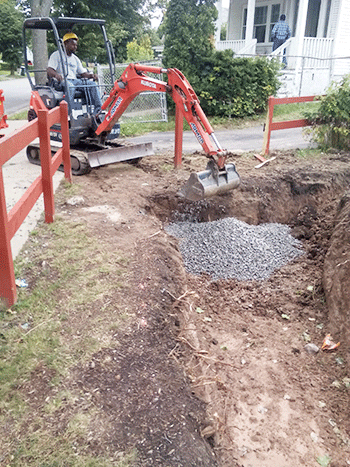
In a recent article in Shelterforce, I talked about PUSH Buffalo’s efforts to create social enterprise businesses around sustainable landscaping and stormwater management. One of our most significant successes with this work has been a partnership with the Buffalo Sewer Authority (BSA) through their Community Water Quality Partnership Program.
In the summer of 2015, we were on the brink of signing a substantial contract with the BSA to carry out sustainable landscaping treatments on close to 23 acres of land throughout the city of Buffalo. Before we could sign, however, we needed to produce proof that we had secured a payment and performance bond. With pressure from the BSA to get started so they could meet tight grant deadlines and a crew anxious to get to work (and whose payroll I needed the BSA dollars to fund), I reached out to PUSH’s existing insurance brokers for assistance with the bond.
As a large organization, PUSH has a variety of policies to cover its work, and the bond, while new, felt like just an additional piece of insurance. A former insurance broker who sat on our finance committee and our director of finance both suggested we honor relationships and go with our existing broker. The broker raised a few concerns about a nonprofit getting a bond for what was their largest contract ever, but then assured me that it could get done.
And then months went by. Every few days there was a new form to be filled out or new requirements, one being that our executive director needed to personally guarantee the bond, which sparked new concerns, and more delays.
Our broker, however, assured us that the bond would be issued any day, which we told the BSA and our board. We even believed it ourselves, so we started work before the contract was signed. Now we had bills from soil providers, subcontractors, and our own payroll—but no bond and no contract. It kept dragging on, for another nine agonizing and expensive weeks…
Taking significant risk like this is a core part of PUSH’s success and ultimately worked in our favor, but it was agonizing while in the midst of it to know how close this could bring us to bankruptcy.
Finally, the BSA directed us to SUNY Buffalo State’s Small Business Development Center, which, in turn, directed us to a large insurance firm in Buffalo that billed itself as “one of the largest, most experienced surety bond and construction bond teams across New York.” They lived up to their claim! Within 10 days of starting our conversations, I was racing down to City Hall to deliver proof of our bond and sign our contract.
What did I learn from this experience? It should’ve been obvious to me from the beginning that if I needed a bond, I should’ve gone to bond experts, but this was a new business line to us, and we didn’t know bond experts or what to expect from the process. We also had relationships with our existing providers, who had served us well in other business lines, so there was a certain logic to our expecting they would serve us well here. But without new partners with new capacities, we’d still be digging ourselves deeper into a financial crisis and not doing the work.
This goes beyond bonds. One of the challenges with branching out into new work—is we often need a whole new team to get the job done.
We learned that lesson. Now we say, “new business equals new partners for new success!”
(Photo credit: courtesy of PUSH Buffalo)





Comments